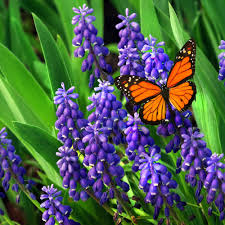Written by Barbara Pleasant | October 17, 2024
For a delightful, low-maintenance gardening project, consider potting up muscari bulbs. Commonly known as grape hyacinths, these spring-flowering bulbs are a breeze to grow in containers, adding vibrant color and charm to your outdoor spaces. Once their mid-spring blooms have brightened your pots, the clumps can be transplanted into the garden, where they’ll rebloom for years with minimal care. Whether lining pathways or filling gaps between hostas, muscari bulbs are versatile and reliable perennials.
Why Choose Muscari?
One of the most practical reasons to grow grape hyacinths is their resistance to animals. Unlike tulips and crocuses, muscari bulbs contain a bitter compound called comisic acid, deterring voles, squirrels, chipmunks, and even pets. Their leaves are also unappetizing to rabbits, though deer may still nibble when food is scarce. Compact and easy to manage, muscari plants can be protected with simple cages when needed.

Selecting the Best Muscari Varieties
Muscari species, native to regions spanning Spain to the Middle East, include hundreds of wild-growing varieties. Among the most prized for gardens is Muscari armeniacum, a large-flowered species with origins in Iraq. Hybridized extensively, many varieties now boast a light, fruity fragrance.
If you’re growing muscari in containers, consider light-colored varieties. A recent trial by the Royal Horticultural Society revealed that cultivars such as ‘Ocean Magic’ and ‘Peppermint’ (light blue) and ‘Alaska’ (almost white) often outshine the traditional dark blue types when displayed in pots. The finer details of these lighter blooms are particularly captivating up close.
How to Grow Muscari in Containers
- Start with Cold Treatment: After purchasing bulbs, refrigerate them for 10 weeks at or below 40°F (4.5°C). This chilling period ensures uniform and robust blooming.
- Choose the Right Containers: Use any weatherproof pot with drainage holes. Shallow containers work perfectly since muscari require little root space. Reused plastic pots make excellent starter containers.
- Planting Steps:
- Add 2 inches (5 cm) of gritty, fast-draining potting soil to the container.
- Arrange bulbs no more than 2 inches (5 cm) apart. In small pots, pack bulbs shoulder to shoulder.
- Cover the bulbs with soil and water thoroughly.

- Outdoor Storage: Place the pots in a protected outdoor spot or bury them in a garden bed covered with mulch. Over winter, the bulbs will develop roots and begin sprouting green shoots in early spring.
Once growth appears, move the pots to decorative containers for display. Provide regular water and sunlight, but feeding isn’t necessary.
Aftercare Tips for Potted Muscari
After the blooms fade, give the bulbs a thorough soaking and transplant them into the garden. Ideal for partially shaded areas, rock gardens, or as walkways’ edging, muscari thrive in spots with winter sun and good drainage.
Post-transplant, muscari may go dormant before reemerging in early autumn with thin leaves that grow into winter. These leaves prepare the plant for a vibrant spring show. Avoid cutting back foliage in early summer, as it allows the bulbs to recharge. If desired, a balanced organic fertilizer can be applied after flowering to encourage vigorous growth.
With proper care, muscari will reward you with stunning blooms year after year, making them a perfect addition to your spring garden.
